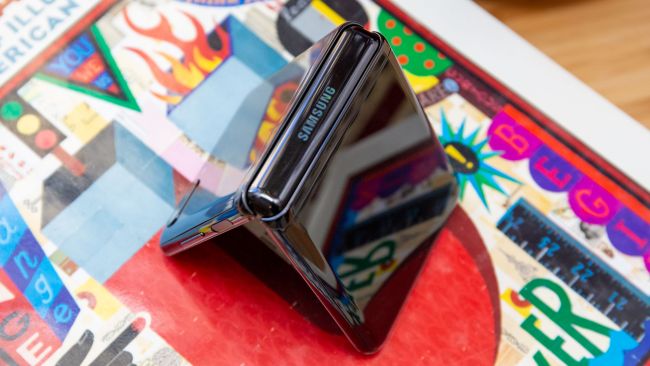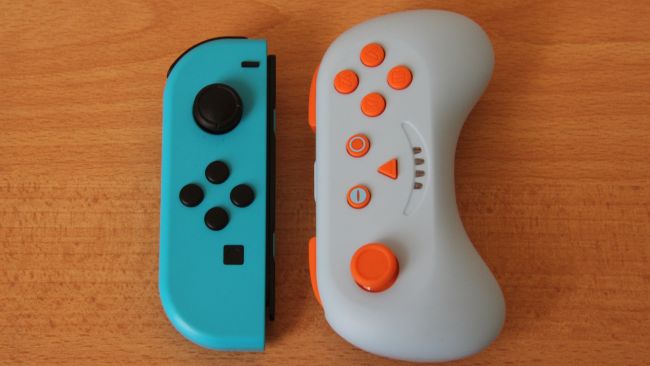Samsung Galaxy S20 Plus two-minute takeaway
The Samsung Galaxy S10 Plus was TechRadar’s top phone of 2019, and its successor, the Galaxy S20 Plus, stands on the shoulders of that giant, adding a range tweaks and improvements to incorporate the cutting edge tech innovations we’ll see in 2020’s flagships.
Arguably the headline feature of the Galaxy S20 Plus is its screen, as there’s an assortment of features here that should combine to create a great viewing experience – between the 120Hz refresh rate, WQHD+ screen tech and the high resolution, there’s a lot to like regardless of what you use your phone for.
The Galaxy S20 Plus cameras see a modest upgrade from the S10 Plus, with the cameras packing larger sensors to hopefully take slightly better pictures. Pictures taken are a little better than on the Galaxy S10 Plus, although unless you’re a huge photography buff you may not notice the difference. There is one large improvement in the camera department – the telephoto lens now has a 64MP sensor, over 12MP, and can facilitate 3x optical zoom instead of 2x.
There are a few other minor spec bumps, like a slightly bigger battery, an all-new chipset for Samsung phones, 5G connectivity (depending on your region) and more RAM. However, these are arguably balanced out by a few notable weaknesses.
For example, we feel the Galaxy S10 Plus had a better design, with a distinctive camera array and 3.5mm headphone jack included.
On top of that, the S20 Plus has a new bigger brother to contend with, which the Galaxy S10 Plus didn’t (if you don’t include the rather niche Galaxy S10 5G). The Samsung Galaxy S20 Ultra is bigger, and has a larger battery capacity and an impressive 108MP main camera, which inevitably makes the Galaxy S20 Plus feel a little underwhelming by comparison.
These contextual details aside, though, the Samsung Galaxy S20 Plus is an accomplished phone with a few notable improvements over its predecessor, and if you’re upgrading from a pre-S10 device, it’s definitely worth looking at this device.
Want to find out more about how we found the phone? Read on below:
Samsung Galaxy S20 Plus release date and price

The Samsung Galaxy S20 Plus 5G price is set at $1,199 / £999 / AU$1,649 / AED 3,799 in the US, UK, Australia and the UAE respectively. That princely sum will get you 12GB RAM and 128GB internal storage, which you can expand on by up to 1TB with a microSD card.
For comparison, the Samsung Galaxy S10 Plus launch price was $999 / £899 / AU$1,499 for the 128GB model, which had 8GB RAM, with the price going up for more storage, so the S20 price looks like a fairly substantial hike in US but not as much in the UK or Australia – and, thanks to subsequent price cuts, the Samsung Galaxy S10 Plus is now available for significantly less than at launch.
Those in Australia and the UAE can get a 4G version of the phone for AU$1,499 / AED 3,599 with 8GB of RAM and 128GB of storage, but that's not available to everywhere else in the world.
In terms of availability, the release date is staggered across the world. The phone will go on sale in the US, Australia and UAE on March 6, but in the UK it’s a week later, on March 13, with pre-orders opening on February 12 for Australia and UAE, and late February for everyone else.
Screen and overall size
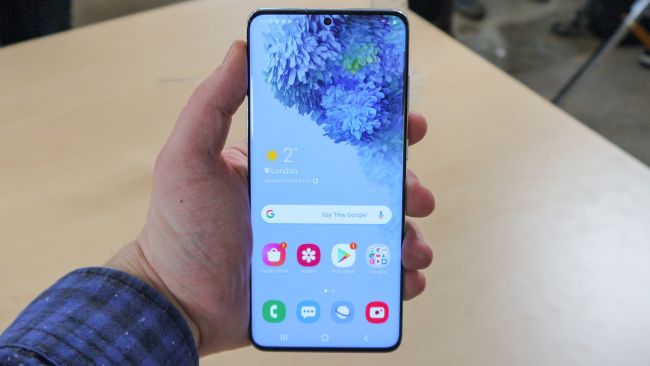
The Samsung Galaxy S20 Plus has a 6.7-inch screen, which is quite a jump from its predecessor’s 6.4 inches, though not quite as palm-stretching as the Galaxy S20 Ultra’s 6.9-inch display.
It’s an AMOLED screen, with a punch-hole camera aperture in the top-center of the display – according to Samsung this is 55% smaller than the punch-hole on the S10 series of phones, and we can attest to the fact that it’s barely noticeable when you’re using the phone, although it’s still more intrusive than a pop-up camera would be.
The resolution here is 3200 x 1440, Wide Quad High-Definition Plus (WQHD+), which is a step up from 2K but not quite the 4K resolution of one or two other smartphone screens. As with nearly all smartphones, it’s possible to drop down to lower resolutions if you want, and you may be doing so if you want a longer battery life and high refresh rate (more on this later). Still, it’s one of the most high-res displays you can find right now.

You’re also getting a 120Hz refresh rate, which means the display updates the image you’re seeing 120 times per second, twice as fast as a typical phone screen. In theory, this means motion is smoother than it otherwise would be, which some phone fans like for scrolling through social media channels and playing games.
We noticed that you can either enable the top resolution option or the highest frame rate, not both, so you can either have WQHD+ at 60Hz, or enjoy the faster 120Hz refresh rate, but only at Full HD+ resolution. Since high refresh rates and crisp resolutions are both all the rage in smartphone displays, it’s odd that Samsung is making phone fans choose one or the other, especially given other phones with high refresh rates don’t.
Some people might not really notice screen quality though, or might not care what refresh rate they use, so this problem won't annoy everyone. However if you strive for top screen quality on your smartphone, know that you're picking resolution or refresh rate here, not both.
Design
The Samsung Galaxy S10 Plus wasn’t the most breathtaking of phones, but it was at least distinctive, with its horizontal camera block and chic metal frame, while the curved display meant it felt great in the hand.
We’re sad to report that the Galaxy S20 Plus looks far more generic in comparison. Firstly, the rear camera block has been shifted to the top-left, the same position we have seen, and expect to continue to see, in plenty of 2019 and 2020 smartphones. The glass back (instead of ceramic) doesn’t feel as great to hold, and the particular placement of the front-facing camera ends up blocking just as much screen content as a notch would.
There are likely reasons for the camera bump and build material changes, like optimal use of space inside the device and better protection respectively, but the result is that the Galaxy S20 feels less like a ‘Samsung phone’ than we’d like.
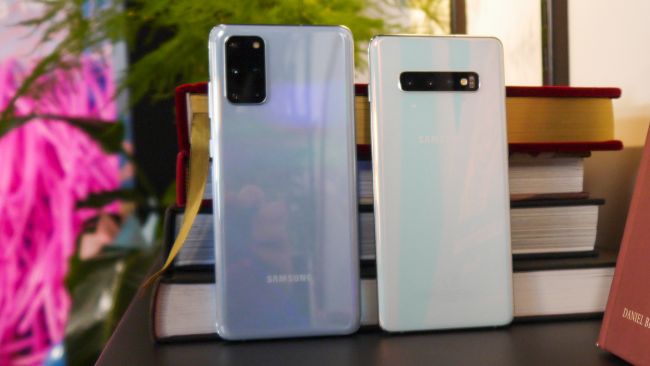
The phone is big but not huge, with a 161.9 x 73.7 x 7.8mm body, and it’s not too heavy at 186g (a touch up from the relatively rare glass-backed S10 Plus, but lighter than the ceramic model).
The phone is available in Cloud Blue, Cosmic Gray or Cosmic Black color options, meaning the Cloud Pink colors will be limited to the smaller S20 model. These colors depend on the region you're in though, so not all options will be available to all buyers.
Four cameras
You’re getting four rear cameras on the Samsung Galaxy S20 Plus. That’s the same number as on the Galaxy S10 Plus, and the shooter may not look different on paper but there are some key improvements.
The main camera here has a 12MP sensor, with a f/1.8 aperture – the Galaxy S10 phones had f/1.5 and f/2.4 variable aperture, so arguably the S20 main camera is actually a little less versatile. Saying that, the sensor size of the S20’s main camera is actually a bit bigger, so it’s likely image quality will be better – we’ll put the camera through its paces properly for our full review.

There’s also an ultra-wide camera with a 12MP lens and f/2.2 aperture. It’s worth noting that the S10 ultra-wide camera had a 16MP sensor, so the resolution is actually a slight downgrade, but again improved sensor size may still result in image quality being bigger. Saying that, we didn’t find the difference very noticeable, and ultra-wide pictures still looked great.
If you want to hear about real camera improvements, though, the zoom camera is where it’s at. Forget the S10’s 12MP telephoto camera: the S20 has a 64MP snapper with a telephoto lens that facilitates 3x optical zoom, as well as 30x digital zoom. While this isn’t the greatest zoom capability ever, beaten as it is by the S20 Ultra and its 10x optical / 100x digital (as well as plenty of non-Samsung phones), it’s still very versatile and allows you to close distances and still take great shots.
With most phone cameras, when you change the zoom factor the UI stutters a bit before jumping straight to the new setting, but here the transition is wonderfully smooth. We’re huge fans of this small change, as it lets you see in better detail what you’ve zoomed in on, which is particularly useful when you’ve zoomed in a fair way.

Finally, there’s a ‘time-of-flight’ (ToF) lens used for depth sensing; these are included on many phones to distinguish between subjects and backgrounds for more accurate ‘bokeh’ blur effects, but we’ve yet to find a phone where it really makes a difference.
On the front you’ll find a 10MP selfie camera, the same as on the Galaxy S10 and Note 10 phones, and we were big fans of this during our testing. Detail, color and lighting were all on point in our selfies, and the Live Focus mode, which lets you add background blur and color effects, was generally pretty accurate, although now and then it had trouble working out if our hair was in the foreground or background.
In general, the pictures we took with the Samsung Galaxy S20 Plus looked very good, and this is probably thanks to Samsung’s fantastic post-processing and scene optimization software, which uses AI to improve your snaps.
There are also a range of intriguing camera features, which we tested briefly but need to spend more time with. Single Take lets you press one button to take a short video using all three rear cameras, then the AI shows you a few of the best photos from the clip. There’s also a new 64MP mode that lets you take high-res pictures without the typical pixel-binning that occurs.
The main reason you'd want to look at Samsung's store shelves for a decent camera phone is because of how easy to use the devices are. The automatic scene optimization, snappy app and easily-accessible options and features make it really easy to use the camera to take great pictures, so there's less pressure for you to spend ages taking a great shot.
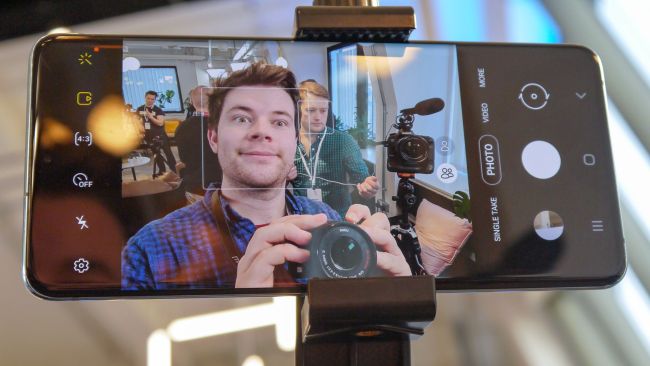
Samsung has been keen to emphasise how many video capture improvements it’s incorporated in the Galaxy S20 phones. The big highlight here is that 8K video capture is now available, so if you’re one of the lucky few people to have any way of viewing this resolution you can use your phone to capture ultra-high-res footage.
Samsung hasn’t revealed whether the 8K footage is native 8K or created using digital upscaling technology, but because the main sensor is 12MP, a lower resolution than 8K requires, we’re assuming it’s digital 8K.
There are a few new video capture modes too, including Pro Video, which is similar to Pro Photo mode, and lets you adjust settings such as aperture, ISO and white balance while shooting clips; an improved image stabilizer; and hyperlapse modes for capturing videos over a long period of time.
5G, battery life, specs and software
Depending on where you live in the world, the Samsung Galaxy S20 either comes with a Qualcomm Snapdragon 865 or Samsung’s own Exynos 990 processor. We’re not sure of the exact breakdown by country just yet, as rumors suggest Samsung is considering breaking its habit of using Snapdragon in the US and China and Exynos elsewhere.
The Snapdragon 865 chipset has a 5G modem, so Samsung Galaxy S20 Plus handsets with this chipset are 5G phones, while it’s possible countries with Exynos devices will end up with 4G phones. In the UK and US, only 5G versions are available but Samsung is releasing a few 4G versions of the S20 and S20 Plus in different regions, so depending where you live you could get your hands on a 4G version if you really want (if you appreciate the lower cost or don’t feel 5G is necessary just yet).
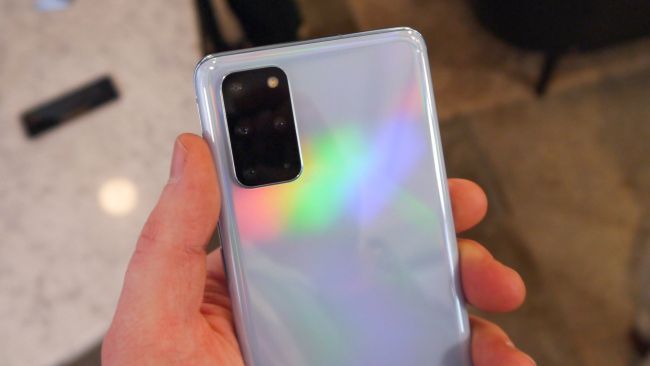
Samsung’s go-to example of choice for how 5G will benefit you, is suggesting that video calling will be much improved, although it’s also listed a few more benefits like faster and smoother online gaming. From our own experience, we’d suggest your mileage with 5G will depend more on which network you’re on, and how extensive its 5G networks are, than on the 5G phone you’re using.
We’d expect the Snapdragon and Exynos chipsets to offer incredibly fast processing power, as well as perhaps extra benefits such as battery optimizations, but they won’t necessarily perform identically, so we’ll have to test those phones separately to see if the processing power is much different.
In terms of operating system, the Samsung Galaxy S20 Plus runs Android 10 with Samsung’s One UI laid over the top, but in the next few years the phone will certainly be supported with the newest Android updates.
The Samsung Galaxy S20 has a 4,500mAh battery, which is on the large side for a top-end smartphone, although there are plenty of devices that better that capacity. Thanks to the 120Hz or WQHD+ display, we’d expect this to last about a day, but only more if you disable these top features.
In terms of charging, there’s 25W fast charging via USB-C, or ‘Fast Wireless Charging 2.0’ as Samsung calls the alternative, although we don’t yet know just how fast this option is. The Wireless Power Share feature is also available, enabling you to charge your Samsung Galaxy Buds Plus, smartwatch, or other Qi-charging device by placing it on the back of your phone.
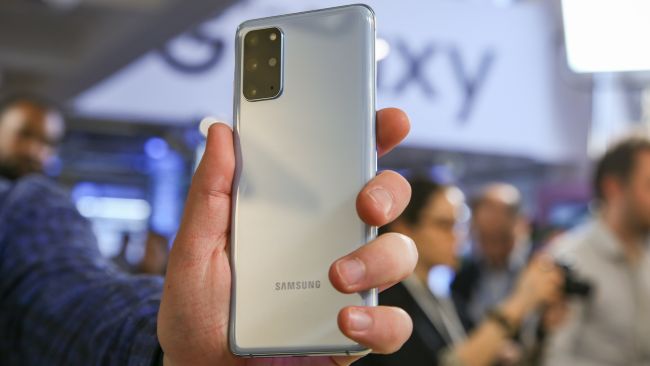
Early verdict
The Samsung Galaxy S20 Plus brings a few improvements that might be very tempting to a certain set of users, depending on what you want from your phone. The screen tech is impressive (if you can get over the fact that you can’t enjoy all the features at the same time), and the zoom lens promises to be great for long-distance photography.
If you already own the Samsung Galaxy S10 Plus, though, or a similarly recent flagship device, its direct successor might not be as big an improvement as you were hoping for – it seems that Samsung has saved its coolest features for the S20 Ultra. At this high price, too, we’d have hoped for a little more from the phone.
It’s possible the S20 Plus has hidden talents that we weren’t able to fully appreciate in our short hands-on review time; if so we’ll hope to discover them during our extensive full review process, but right now we’re not entirely convinced. Stay tuned for our in-depth Samsung Galaxy S20 Plus review in the coming weeks to find out whether or not its a worthy upgrade to its predecessor or not.

